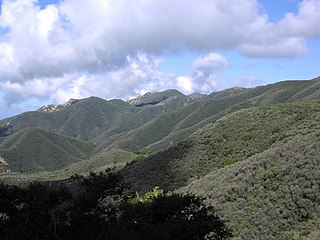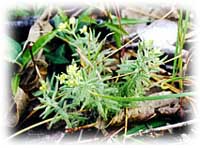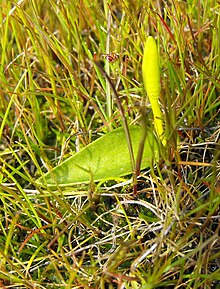
Chaparral is a shrubland plant community and geographical feature found primarily in the U.S. state of California, in southern Oregon, and in the northern portion of the Baja California Peninsula in Mexico. It is shaped by a Mediterranean climate and infrequent, high-intensity crown fires. Chaparral features summer-drought-tolerant plants with hard sclerophyllous evergreen leaves, as contrasted with the associated soft-leaved, drought-deciduous, scrub community of coastal sage scrub, found often on drier, southern facing slopes within the chaparral biome. Three other closely related chaparral shrubland systems occur in central Arizona, western Texas, and along the eastern side of central Mexico's mountain chains (mexical), all having summer rains in contrast to the Mediterranean climate of other chaparral formations. Chaparral comprises 9% of California's wildland vegetation and contains 20% of its plant species. The name comes from the Spanish word chaparro, which translates to "place of the scrub oak".

The California Floristic Province (CFP) is a floristic province with a Mediterranean-type climate located on the Pacific Coast of North America with a distinctive flora similar to other regions with a winter rainfall and summer drought climate like the Mediterranean Basin. This biodiversity hotspot is known for being the home of the Sierran giant sequoia tree and its close relative the coast redwood. In 1996, the Province was designated as a biodiversity hotspot allowing it to join ranks among 33 other areas in the world with many endemic species. To be named a biodiversity hotspot, an area has to contain species and plant life that cannot be found anywhere else in the world. The California Floristic Province is home to over 3,000 species of vascular plants, 60% of which are endemic to the province.

Baccharis pilularis, called coyote brush, chaparral broom, and bush baccharis, is a shrub in the family Asteraceae native to California, Oregon, Washington, and Baja California. There are reports of isolated populations in New Mexico, most likely introduced.

Papaver californicum is a species of poppy known by the common names fire poppy and western poppy.

Dryopteris arguta, with the common name coastal woodfern, is a species of wood fern. It is native to the west coast and western interior mountain ranges of North America, from British Columbia, throughout California, and into Arizona.

Tetracoccus dioicus, known by the common names red shrubby-spurge and Parry's tetracoccus, is a species of flowering plant.

Arctostaphylos tomentosa is a species of manzanita known by the common name woollyleaf manzanita or woolley manzanita. This shrub is endemic to California.

Ephedra californica is a species of Ephedra, known by the common names California jointfir, California ephedra, desert tea, Mormon tea, and cañatillo.

Galium californicum is a species of flowering plant in the coffee family known by the common name California bedstraw.

Arctostaphylos pallida, commonly known as pallid manzanita, Oakland Hills manzanita, and Alameda manzanita, is an upright manzanita shrub from the Ericaceae, or heath family. It is endemic to the eastern San Francisco Bay Area of Northern California.

Lepechinia ganderi is a rare species of perennial shrub in the mint family known by the common name San Diego pitcher sage or Gander's pitcher sage. An aromatic plant with white to lavender flowers, this species is only known from southern San Diego County in California and a small portion of Baja California, occurring on chaparral or coastal sage scrub in metavolcanic soils. Because of its limited range, it is under threat from growing urbanization and increased fire frequency.

Blitum californicum is a species of flowering plant in the amaranth family known by the common names California goosefoot and (ambiguously) "Indian lettuce".

Arctostaphylos refugioensis is a species of manzanita, known by the common name Refugio manzanita. It is endemic to Santa Barbara County, California, where it can be found along the immediate coastline, including the vicinity of Refugio State Beach, and into the Santa Ynez Mountains of the northwestern Transverse Ranges.

Chaenactis glabriuscula, with the common name yellow pincushion, is a species of flowering plant in the daisy family. It is native to California and Baja California.
Myriopteris cooperae, formerly Cheilanthes cooperae, is a species of lip fern known by the common name Mrs. Cooper's lip fern, or simply Cooper's lip fern. The type specimen of this species was collected by Sarah Paxon Cooper and was named in her honor by D. C. Eaton.

Lupinus hirsutissimus is a species of lupine known by the common names stinging annual lupine or stinging lupine. It is native to the coastal mountains of Baja California and Southern California as far north as the San Francisco Bay Area. It grows on dry mountain slopes, including areas that have recently burned, and chaparral and woodlands habitats.

Pycnanthemum californicum is a species of flowering plant in the mint family known by the common name Sierra mint, mountain mint, and California mint.
















